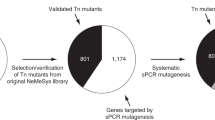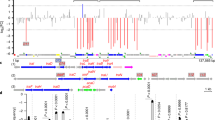Abstract
Identification of genes that encode essential products provides a promising approach to validation of new antibacterial drug targets. We have developed a mariner-based transposon, TnAraOut, that allows efficient identification and characterization of essential genes by transcriptionally fusing them to an outward-facing, arabinose-inducible promoter, PBAD, located at one end of the transposon. In the absence of arabinose, such TnAraOut fusion strains display pronounced growth defects. Of a total of 16 arabinose-dependent TnAraOut mutants characterized in Vibrio cholerae, four were found to carry insertions upstream of known essential genes (gyrB, proRS, ileRS, and aspRS) whereas the other strains carried insertions upstream of known and hypothetical genes not previously shown to encode essential gene products. One of the essential genes identified by this analysis appears to be unique to V. choleraeand thus may represent an example of a species-specific drug target.
This is a preview of subscription content, access via your institution
Access options
Subscribe to this journal
Receive 12 print issues and online access
$209.00 per year
only $17.42 per issue
Buy this article
- Purchase on Springer Link
- Instant access to full article PDF
Prices may be subject to local taxes which are calculated during checkout



Similar content being viewed by others
References
Clayton, R.A., White, O. & Fraser, C.M. Findings emerging from complete microbial genome sequences. Curr. Opin. Microbiol. 1, 562–566 (1998).
Tang, C.M., Hood, D.W. & Moxon, E.R. Microbial genome sequencing and pathogenesis. Curr. Opin. Microbiol. 1, 12–16 (1998).
Schmid, M.B., Kapur, N., Isaacson, D.R., Lindroos, P. & Sharpe, C. Genetic analysis of temperature-sensitive lethal mutants of Salmonella typhimurium. Genetics 123, 625–633 (1989).
Arigoni, F. et al. A genome-based approach for the identification of essential bacterial genes. Nat. Biotechnol. 16, 851–856 (1998).
Mushegian, A.R. & Koonin, E.V. A minimal gene set for cellular life derived by comparison of complete bacterial genomes [see comments]. Proc. Natl. Acad. Sci. USA 93, 10268–10273 (1996).
Akerley, B.J. et al. Systematic identification of essential genes by in vitro mariner mutagenesis. Proc. Natl. Acad. Sci. USA 95, 8927–8932 (1998).
Hutchison, C.A. et al. Global transposon mutagenesis and a minimal Mycoplasma genome. Science 286, 2165–2169 (1999).
Guzman, L.M., Belin, D., Carson, M.J. & Beckwith, J. Tight regulation, modulation, and high-level expression by vectors containing the arabinose PBAD promoter. J. Bacteriol. 177, 4121–4130 (1995).
Rubin, E.J. et al. In vivo transposition of mariner-based elements in enteric bacteria and mycobacteria. Proc. Natl. Acad. Sci. USA 96, 1645–1650 (1999).
Gueiros-Filho, F.J. & Beverley, S.M. Trans-kingdom transposition of the Drosophila element mariner within the protozoan Leishmania (see comments). Science 276, 1716–1719 (1997). (Published erratum appears in Science 277, 753, 1997.)
Harley, C.B. & Reynolds, R.P. Analysis of E. coli promoter sequences. Nucleic Acids Res. 15, 2343–2361 (1987).
Takiff, H.E., Baker, T., Copeland, T., Chen, S.M. & Court, D.L. Locating essential Escherichia coli genes by using mini-Tn10 transposons: the pdxJ operon. J. Bacteriol. 174, 1544–1553 (1992).
Rappleye, C.A. & Roth, J.R. A Tn10 derivative (T-POP) for isolation of insertions with conditional (tetracycline-dependent) phenotypes. J. Bacteriol. 179, 5827–5834 (1997).
Chow, W.Y. & Berg, D.E. Tn5tac1, a derivative of transposon Tn5 that generates conditional mutations. Proc. Natl. Acad. Sci.USA 85, 6468–6472 (1988).
Fullner, K.J. & Mekalanos, J.J. Genetic characterization of a new type IV-A pilus gene cluster found in both classical and El Tor biotypes of Vibrio cholerae. Infect. Immun. 67, 1393–1404 (1999).
Preliminary sequence data was obtained from The Institute for Genomic Research website at http://www.tigr.org.
Heidelberg, J.F. et al. Whole genome sequencing of Vibrio cholerae, the etiologic agent of cholera. In Proceedings of the 35th US–Japan Cholera and Other Bacterial Enteric Infections Joint Panel Meeting 87 (Baltimore, MD; 1999).
Altschul, S.F. et al. Gapped BLAST and PSI-BLAST: a new generation of protein database search programs. Nucleic Acids Res. 25, 3389–3402 (1997).
Schimmel, P., 19. Tao, J. & Hill, J. Aminoacyl tRNA synthetases as targets for new anti-infectives. FASEB J. 12, 1599–1609 (1998).
Samuels, D.S., Marconi, R.T., Huang, W.M. & Garon, C.F. gyrB mutations in coumermycin A1-resistant Borrelia burgdorferi. J. Bacteriol. 176, 3072–3075 (1994).
Hirokawa, T., Boon-Chieng, S. & Mitaku, S. SOSUI: classification and secondary structure prediction system for membrane proteins. Bioinformatics 14, 378–379 (1998).
Nakai, K. & Kanehisa, M. Expert system for predicting protein localization sites in gram-negative bacteria. Proteins 11, 95–110 (1991).
Trucksis, M., Michalski, J., Deng, Y.K. & Kaper, J.B. The Vibrio cholerae genome contains two unique circular chromosomes. Proc. Natl. Acad. Sci.USA 95, 14464–14469 (1998).
Curnow, A.W., Tumbula, D.L., Pelaschier, J.T., Min, B. & Soll, D. Glutamyl-tRNA(Gln) amidotransferase in Deinococcus radiodurans may be confined to asparagine biosynthesis. Proc. Natl. Acad. Sci.USA 95, 12838–12843 (1998).
Ibba, M., Curnow, A.W. & Soll, D. Aminoacyl-tRNA synthesis: divergent routes to a common goal. Trends Biochem. Sci. 22, 39–42 (1997).
Irani, M.H. & Maitra, P.K. Properties of Escherichia coli mutants deficient in enzymes of glycolysis. J. Bacteriol. 132, 398–410 (1977).
Chiang, S.L. & Mekalanos, J.J. Use of signature-tagged transposon mutagenesis to identify Vibrio cholerae genes critical for colonization. Mol. Microbiol. 27, 797–805 (1998).
Schleif, R. Two positively regulated systems, ara and mal. In Escherichia coli and Salmonella, Vol. 1 (ed. Neidhardt, F.C.) 1300–1309 (ASM Press, Washington, DC; 1996).
Sambrook, J., Fritsch, E.F. & Maniatis, T. Molecular cloning: a laboratory manual. (Cold Spring Harbor Laboratory Press, Cold Spring Harbor, NY; 1989).
Metcalf, W.W. et al. Conditionally replicative and conjugative plasmids carrying lacZ alpha for cloning, mutagenesis, and allele replacement in bacteria. Plasmid 35, 1–13 (1996).
Kolter, R., Inuzuka, M. & Helinski, D.R. Trans-complementation-dependent replication of a low molecular weight origin fragment from plasmid R6K. Cell 15, 1199–1208 (1978).
Guiney, D.G. & Helinski, D.R. The DNA–protein relaxation complex of the plasmid RK2: location of the site-specific nick in the region of the proposed origin of transfer. Mol. Gen. Genet. 176, 183–189 (1979).
Mekalanos, J.J. Duplication and amplification of toxin genes in Vibrio cholerae. Cell 35, 253–263 (1983).
Simon, R. et al. A broad host range mobilization system for in vivo genetic engineering: transposon mutagenesis in gram negative bacteria. Bio/Technology 1, 784–791 (1983).
Miller, J.H. Experiments in molecular genetics. (Cold Spring Harbor Laboratory, Cold Spring Harbor, NY; 1972).
Acknowledgements
We thank E.J. Rubin, J.H. Blum, and B.J. Akerley for useful discussions. This work was supported by grant AI-26289 from the National Institute of Allergy and Infectious Diseases (NIAID). Preliminary sequence data was obtained from The Institute for Genomic Research website at http://www.tigr.org. Sequencing of Vibrio cholerae was accomplished also with support from NIAID.
Author information
Authors and Affiliations
Corresponding author
Rights and permissions
About this article
Cite this article
Judson, N., Mekalanos, J. TnAraOut, A transposon-based approach to identify and characterize essential bacterial genes. Nat Biotechnol 18, 740–745 (2000). https://doi.org/10.1038/77305
Received:
Accepted:
Issue Date:
DOI: https://doi.org/10.1038/77305
This article is cited by
-
A modular chromosomally integrated toolkit for ectopic gene expression in Vibrio cholerae
Scientific Reports (2020)
-
A decade of advances in transposon-insertion sequencing
Nature Reviews Genetics (2020)
-
Dual-barcoded shotgun expression library sequencing for high-throughput characterization of functional traits in bacteria
Nature Communications (2019)
-
Prediction of essential proteins based on subcellular localization and gene expression correlation
BMC Bioinformatics (2017)
-
Ubiquitination and degradation of GBPs by a Shigella effector to suppress host defence
Nature (2017)



